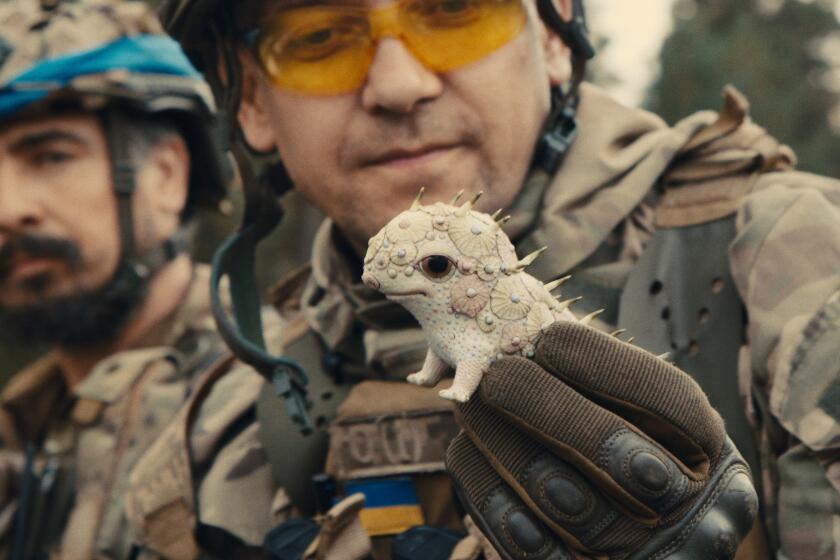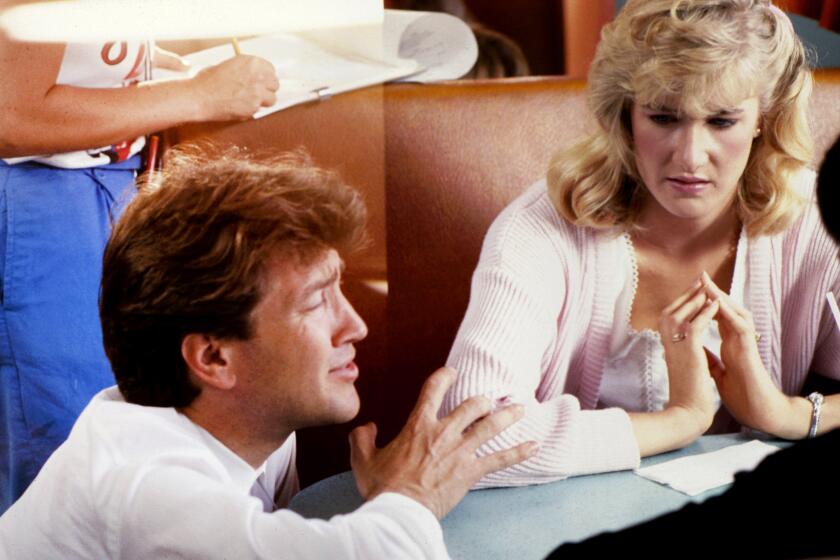OSCAR FOR MENGES? ‘MISSION’ POSSIBLE
- Share via
“The Killing Fields” won British cinematographer Chris Menges a 1984 Oscar, and now he’s been nominated again for his work on “The Mission,” his second collaboration with director Roland Joffe.
“I promise I’ll come this time,” Menges said over lunch in Hollywood the other day. He’d been kept away from the 1985 Academy Awards by the press of family responsibilities--he’s the father of five children whose ages range from 9 to 22.
At 46, the trim, bearded Menges has been in the film industry nearly 30 years, having started at 17 as a tea boy--a time-honored way of getting a start in British films.
With their jungle locales, in Southeast Asia and South America respectively, both “The Killing Fields” and “The Mission” demanded enormous technical skills as well as artistry. To the first, Menges brought the immediacy of war, drawing upon the four Vietnam documentaries he made in the midst of battle, and to the second, a lush grandeur appropriate to the story of two very different priests, played by Jeremy Irons and Robert De Niro, who defy both the Spanish and Portuguese empires in trying to save an Indian tribe in mid-18th Century Latin America.
Menges, however, has been equally effective in less rigorous locations, for he also photographed Scottish film maker Bill Forsyth’s droll comedy “Local Hero” and became established in feature films with Lindsay Anderson’s iconoclastic boarding-school satire, “If. . . .”
Menges came to Joffe’s attention through his work on two highly acclaimed 1973 documentaries on the drug trade, “Opium Warlords” and “Opium Trail,” which he shot and produced with sound man Adrian Cowell for British TV over an 18-month period in the Burmese jungles. He and Joffe’s first feature project, which fell through, was to be filmed in 1975 in strife-torn Angola.
“On ‘Opium Warlords’ there was never a chance to put a tripod down, and Roland liked the searching quality of my style,” said Menges. “Adrian and I were constantly looking for revealing moments and mannerisms.
“Roland is a man of great vision. He’s terribly clear about what he wants, which gives us something to work for. One of the directors he admires is Ken Loach, and his ‘Kes’ was my first film as a director of photography.”
Before filming began on “The Mission,” he said, the two of them “spent a lot of time at the National Gallery in London studying the composition and light of the Spanish masters. We had some scenes in Cartagena, a magnificent, tragic city built by the slave trade. It’s a superb 17th-Century city, and it was a big inspiration for us.
“The hardest part for me on ‘The Mission,’ ” he said, “was working with two cameras. It was just incredibly difficult. It’s very hard to light for two cameras and get that delicate feeling we wanted for ‘The Mission.’ ”
Not surprisingly, the sequences of “The Mission” shot at the immense, cascading Iguazu Falls in South America were a special challenge. “We had miles of walkways put up for the crew just so they could get to work,” said Menges. “With all those streams and boulders, it took the most minute planning just to get the camera in place. I had an Argentinian and Colombian crew, who were spectacular. What was lucky for me was that I had shot the documentary ‘The Tribe That Hides From Man’ in 1968 in the Amazon. Occasionally, it’s nice to work on a big film in the middle of nowhere. Everyone is inspired to work for a common cause.”
Menges spoke with the utmost regard for Loach, whose 1969 “Kes” was a highly regarded film, at once funny and sad, about a boy learning about life from the fate of his pet bird. More recently, he brought that searching camera style of his to Loach’s compelling “Fatherland,” which was shown at AFI Film Fest and which traces the odyssey of an East Berlin singer of protest songs who moves to the West.
“Loach always wants the camera quiet--very fast, quiet and careful. There are no rehearsals, and sound is very important because he wants everything to be very real so that the audience feels it’s happening right now. Roland would like to be a cross between Ken Loach and David Lean--I read it somewhere! With Ken you can’t have a temper tantrum, you can’t say you can’t do it. You can’t say no. He’s quite a training ground; it’s literally ‘free cinema.’ ”
Menges’ interest in films came via theater, for his father was musical director at the Old Vic for 25 years. “I was fascinated by the theater, and then came photography,” Menges explained. “I suppose my lack of education is a great drawback, but who could have had better teachers than I?”
Now comes directing. Menges will make his feature directorial debut in Zimbabwe in June with “A World Apart,” a true story set in Johannesburg in 1963. “It’s about three girls--7, 9 and 13--whose parents got involved in the African National Congress,” he said. “Their mother was arrested and sentenced to 117 days, and their father went overseas. It’s based on a story written by the eldest daughter, who’s now 37, and it’s about what happens to three children when their parents vanish. It could be set anywhere--Northern Ireland, for example.
“I have no intention of giving up cinematography, but every now and then I want to try to solve my own problems. Peter Bizan, who shot ‘Time Bandits’ and ‘Another Country,’ will be my director of photography. He’s a good choice for me, because he has a good sense of light, and I can concentrate on the children. I’m glad I don’t know him too well, because I don’t want to get too involved in the cinematography. I’ll worry about the compositions but not about the light.
“You’d think I’d feel terribly secure by now, but I go to every job as if I were just beginning. I’m a bundle of nerves,” Menges admitted. “With every job there’s a chance of failure.”
“Don’t listen to that!” cut in Menges’ wife, Judy. “Every day for Chris is an opportunity!” Menges just smiled and let his wife have the last word.
More to Read
Only good movies
Get the Indie Focus newsletter, Mark Olsen's weekly guide to the world of cinema.
You may occasionally receive promotional content from the Los Angeles Times.










